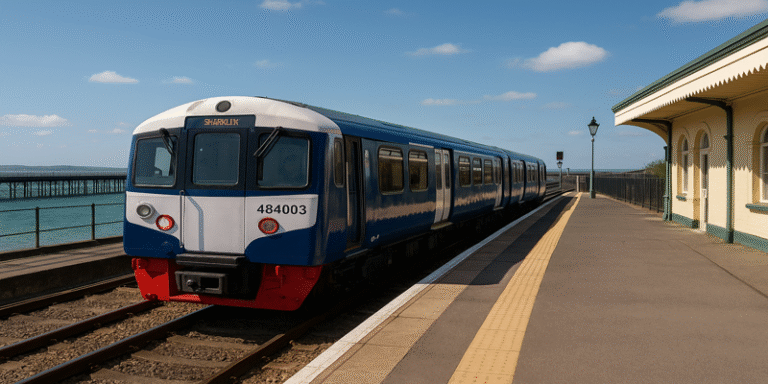Nestled within the scenic charm of the Isle of Wight, the Island Line Railway stands as more than just a mode of transportation—it is a symbol of heritage, sustainability, and tourism development. Running a modest 8.5 miles from Ryde Pier Head to Shanklin, the railway offers a unique blend of historical significance and contemporary utility. As one of the UK’s most distinctive railway lines, its evolution and role in the island’s tourist economy paint a vivid portrait of sustainable travel and heritage preservation in a modern age.
A Brief History of the Island Line
The Island Line Railway dates back to the 1860s, when Victorian Britain saw rapid railway expansion. Built to connect coastal towns, the line initially formed part of a broader network operated by the Isle of Wight Railway Company (Brown, 2017). The line served both residents and tourists, capitalising on the growing Victorian appetite for seaside holidays.
Over time, many parts of the Isle’s network closed, but the Ryde-Shanklin section was preserved, largely due to its strategic location and steady passenger demand. It has continued to evolve, recently undergoing a £26 million upgrade (Network Rail, 2021), with refurbished Class 484 trains replacing the old London Underground stock that had been in use since the 1980s.
Heritage on the Tracks
What makes the Island Line uniquely charming is its historical significance. Trains run along Ryde Pier, the oldest seaside pleasure pier in the world, opened in 1814 (Grydehøj & Hayward, 2011). This connection to the past, both physically and symbolically, is integral to the Isle’s cultural identity.
The railway is a living relic, where industrial archaeology meets holiday nostalgia. Many tourists specifically ride the Island Line for its heritage value, blending convenience with a sense of time travel. As Hose (2025) explains, heritage railways are increasingly recognised as “experiential heritage spaces“, where the journey becomes part of the destination.
A Boost to Local Tourism
The Island Line plays a central role in supporting the Isle of Wight’s tourist economy, particularly as part of the “car-free tourism” initiative (Visit Isle of Wight, 2023). The railway connects with ferry terminals at Ryde Pier Head, allowing seamless travel from London to the beaches of Sandown and Shanklin.
This integration supports sustainable tourism by reducing car traffic and encouraging eco-conscious travel. According to Currie and Falconer (2014), transport infrastructure on islands like the Isle of Wight must balance accessibility with environmental impact—a balance the Island Line strives to achieve.
Furthermore, attractions like the Isle of Wight Steam Railway, which intersects with the Island Line at Smallbrook Junction, enrich the area’s tourism offering. This synergy between different modes of rail-based attractions fosters extended stays and heritage exploration.
Environmental and Economic Sustainability
The Island Line stands as a model of sustainable transport on a small island. Its recent modernisation includes energy-efficient trains, platform improvements, and better accessibility, aligning with the UK’s wider net-zero goals (DfT, 2020).
Unlike larger national networks, the Island Line is tailored to its local geography and tourism cycles, making it more adaptable and economically efficient. As Grydehøj (2014) notes in his comparison of small island infrastructures, adaptable local transport systems are key to island sustainability, particularly where tourism is seasonal.
Additionally, maintaining a functional railway reduces road congestion, improves air quality, and supports local employment, especially during the summer season when the Isle of Wight’s population can double due to tourism (ONS, 2021).
Challenges and Opportunities
Despite its charm and importance, the Island Line faces several challenges:
- Funding constraints due to its limited size and seasonal ridership.
- Infrastructure upkeep, especially the ageing Ryde Pier, which is vital for ferry-rail connections.
- Balancing heritage with modern expectations, such as accessibility for disabled tourists and integration with digital ticketing systems.
However, these challenges also present opportunities for innovation. Partnerships with local councils, the National Trust, and private tour operators can enhance marketing, funding, and community engagement. Initiatives like “Rail Ale Trails” and eco-tours can help monetise the route in creative and culturally enriching ways (Thomas et al., 2017).
A Ride Worth Remembering
For visitors, riding the Island Line is more than just a way to get from Ryde to Shanklin—it’s an experience that showcases the natural beauty of the island, the historical layers of British tourism, and the future of sustainable travel. Passengers are treated to views of coastal landscapes, quaint seaside villages, and charming Victorian architecture.
From the wooden expanse of Ryde Pier to the sandy shores of Shanklin, each stop offers opportunities for photography, exploration, and immersion into the Isle’s slow-paced island culture.
The Island Line Railway is a vital asset for the Isle of Wight’s tourism industry, a symbol of sustainable transport, and a treasure trove of British railway heritage. It connects people not just physically, but emotionally—to the landscape, the history, and the charm of island life.
As the tourism sector increasingly embraces eco-friendly travel, the Island Line serves as an inspiring case study. Its continued success will depend on strategic investment, innovative tourism offerings, and respect for the island’s unique identity.
References
Brown, J. (2017). The Railway Preservation Revolution: A History of Britain’s Heritage Railways. Pen & Sword Books.
Currie, C. & Falconer, P. (2014). Maintaining sustainable island destinations in Scotland: The role of the transport–tourism relationship. Journal of Destination Marketing & Management, 3(3), 162–172.
DfT (Department for Transport). (2020). Decarbonising Transport: Setting the Challenge. [Online] Available at: https://www.gov.uk/government/publications/decarbonising-transport-setting-the-challenge.
Grydehøj, A. & Hayward, P. (2011). Autonomy initiatives and quintessential Englishness on the Isle of Wight. Island Studies Journal, 6(2), 179–202.
Grydehøj, A. (2014). Social and economic effects of spatial distribution in island communities: Comparing the Isles of Scilly and Isle of Wight, UK. Journal of Marine and Island Cultures, 3(2), 45–53.
Hose, T.A. (2025). Travel, Sea Air and (Geo) Tourism in Coastal Southern England. Tourism and Hospitality, 6(3), 155. Available at: https://www.mdpi.com/2673-5768/6/3/155.
Network Rail. (2021). Island Line Upgrade Completion. [Online] Available at: https://www.networkrail.co.uk/news/island-line-railway-upgrade-complete/.
ONS (Office for National Statistics). (2021). Tourism in Coastal Areas: Visitor Demographics and Travel Trends. [Online] Available at: https://www.ons.gov.uk.
Thomas, B., Thomas, S. & Powell, L. (2017). The Development of Key Characteristics of Welsh Island Cultural Identity and Sustainable Tourism in Wales. Scientific Culture, 3(1), 45–58.
Visit Isle of Wight. (2023). Car-Free Travel on the Island Line. [Online] Available at: https://www.visitisleofwight.co.uk/information/car-free-travel.









